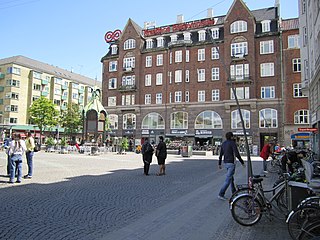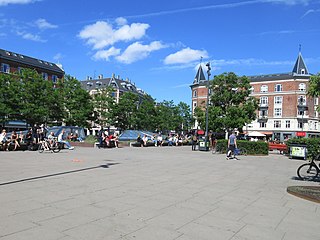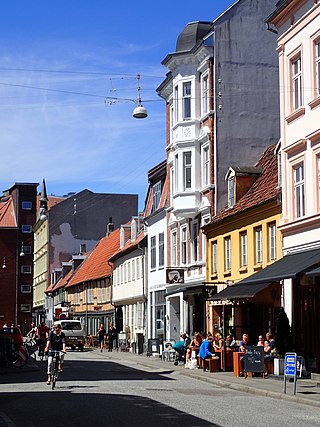
Vesterbros Torv is a public square located at the corner of Vesterbrogade and Gasværksvej in the heart of the Vesterbro district of Copenhagen, Denmark. It is dominated by Elijah's Church.

Vesterbros Torv is a public square located at the corner of Vesterbrogade and Gasværksvej in the heart of the Vesterbro district of Copenhagen, Denmark. It is dominated by Elijah's Church.


The square was established in 1850. Its triangular shape of the space was determined by a series of rope walks which used to be located at the site. The two buildings which flank Elijah's Church date from the establishment of the square.
The church was completed as an infill in 1907. It is designed by Martin Nyrop.
On the opposite side of the square, the two buildings which flank the passageway which passes through The New Theatre, one of them with a characteristic tower, was built as part of the large theatre complex. The theatre was inaugurated in 1908 and is built to a design which mixes Art Nouveaux with other styles.

The Hercules Fountain dates from 1915 and was a gift from the society Hovedstadens forskønnelse. It was designed by the sculptor Rasmus Harboe who had previously created the reliefs on the facade of Elijah's Church. [1]
A plaque on No. 55A commemorates the World War II resistance fighter Erik Koch Michelsen. He was shot at the site on 3 March 1945.
In 1901 city architect Ludvig Fenger fitted the square with underground lavatories. Similar facilities were constructed at the City Hall Square, Amagertorv and Nyhavn.

Aarhus C is a postal district in the city of Aarhus, Denmark, consisting of the Inner city, Vesterbro, University of Aarhus, Frederiksbjerg, Langenæs and Aarhus Ø, with postal code 8000. The district is commonly defined as the area enclosed by the ring road of Ring 1, and in the west by the Aarhus Harbour and shoreline.

City Hall Square is a public square in the centre of Copenhagen, Denmark, located in front of the Copenhagen City Hall. Its large size, central location, and affiliation with the city hall makes it a popular venue for a variety of events, celebrations and demonstrations. It is often used as a central point for measuring distances from Copenhagen.

Nytorv is a public square in the centre of Copenhagen, Denmark. Together with the adjoining Gammeltorv it forms a common space, today part of the Strøget pedestrian zone. The square is dominated by the imposing Neoclassical façade of the Copenhagen Court House, which from 1815-1905 also served as the City Hall.

Vesterbro is a neighbourhood of Aarhus, Denmark. It is located in the Aarhus C district, west of the city centre of Indre By. Vesterbro used to be farmland outside the city walls, and the neighbourhood's development progressed, when the city walls of Aarhus were demolished in 1851.

Vesterbrogade is the main shopping street of the Vesterbro district of Copenhagen, Denmark. The 1.5 km long street runs from the City Hall Square in the east to Pile Allé in Frederiksberg in the west where it turns into Roskildevej. On its way, it passes Copenhagen Central Station as well as the small triangular square Vesterbros Torv. It is one of four such -bro streets, the other being Nørrebrogade, Østerbrogade and Amagerbrogade.

Sankt Hans Torv is a public square in the heart of the Nørrebro district of Copenhagen, Denmark. It is dominated by a large granite sculpture by Jørgen Haugen Sørensen and is known for its thriving café scene. St. John's Church, the largest and oldest church in Nørrebro, is situated just east of the square.

Elijah's Church is a Church of Denmark parish church located on Vesterbros Torv in the heart of the Vesterbro district of Copenhagen, Denmark. Completed in 1908 and designed by Martin Nyrop, who has designed Copenhagen City Hall, it was the largest church to be built by the Copenhagen Church Foundation.

Halmtorvet is a public square in the Vesterbro district of Copenhagen, Denmark. It is located next to Copenhagen Central Station in front of the Meat District. The oblong square eventually turns into Sønder Boulevard, a broad street with a park strip in its central reserve, which continues to Enghavevej at Enghave station.
Rasmus Harboe was a Danish sculptor. He was a frequent collaborator with several of the leading Danish architects of his time, including Martin Nyrop.

Østerfælled Barracks, later known as Østerbrogade Kaserne, was a barracks originally built in the 1890s for the Guard Hussars of the Royal Danish Army in the emerging Østerbro district of Copenhagen, Denmark. Its grounds have now been transformed into a mixed-use development surrounding a pedestrian zone and is now known as Østerfælled Torv. Many of the old buildings have been retained while others have been demolished to make way for new residential buildings. The old main entrance to the barracks is located on the corner of Østerbrogade and Gunner Nu Hansens Plads.

Østerfælled Torv is a mixed-use development surrounding a public space by the same name in the former grounds of Østerfælled Barracks in the Østerbro district of Copenhagen, Denmark. It is a result of a redevelopment of the site in the 1990s which preserved many of the old buildings, now used for retail and commercial space as well as cultural facilities, combining them with new apartment buildings.

Christianshavns Torv is the central public square of the Christianshavn neighborhood in Copenhagen, Denmark. It is situated at the intersection of Torvegade and Christianshavn Canal, roughly at the center of the area.

Enghave Plads is a central public square of the Vesterbro district in Copenhagen, Denmark. It is located where Istedgade reaches Enghavevej, which separates the square from Enghave Park.

Gunnar Nu Hansens Plads is a public space in the Østerbro district of Copenhagen, Denmark. It consists of a triangular plaza, located on the west side of Østerbrogade, just north of Parken Stadium, which turns into a wide street and continues for about 200 m to Fælledparken, The street then continues southwest as Per Henrik Lings Allé to Øster Allé. Several sports venues, some of which are listed, are located on the south side of the square. The former Østerfælled Barracks, now a mixed-use development known as Østerfælled Torv, are located on its north side.

Vestergade is a street in Aarhus, Denmark, which runs east to west from the central square of Store Torv to the city park of Åparken at Carl Blochs Gade, intersecting the main streets of Grønnegade and Vester Allé along its course. Vestergade begins in the Indre By neighborhood and ends in neighborhood of Vesterbro, close to CeresByen. Vestergade has some of the best preserved 18th-century merchant estates in Aarhus and a history of creativity and artistic expression.

The architecture of Aarhus comprises numerous architectural styles and works from the Middle Ages to present-day. Aarhus has a well-preserved medieval city center with the oldest dwellings dating back to the mid-1500s and some ecclesiastical structures such as St. Clemen's Cathedral and numerous smaller churches that can be traced back to the 1100s. The industrialization of the 19th and 20th centuries left distinctive industrial structures, important National romantic works and some of the best examples of Functionalist architecture in the country. The history of the city as a Viking fort is evidenced in the street layout of the Latin Quarter, the wider Indre By neighborhood testifies to its later role as a Market town and center of commerce while the Frederiksbjerg, Trøjborg and Marselisborg districts showcase the first cohesive urban planning efforts of the early 20th century.

A/S Københavns Telefonkiosker, often referred to as KTK, was an operator of staffed telephone kiosks in Copenhagen, Denmark. The first telephone kiosks were installed in 1896 to an Art Nouveau-influenced National Romantic design by Fritz Koch. A new and somewhat larger model was introduced in 1913 but Koch's original design was again used when a number of new telephone kiosks were installed in 1929.

Vesterbro Torv is a public square located in the Vesterbro neighborhood of Aarhus, Denmark. Vesterbro Torv is the junction where 8 street meet; Vesterbrogade, Hjortensgade, Langelandsgade, Teglværksgade, Nørre Allé, Vesterport, Vester Allé and Janus la Cours Gade. It is one of the most heavily trafficked areas in the city, receiving traffic from Åbyhøj and Brabrand in the west along Silkeborgvej and from Tilst in the north-west along Viborgvej. The square is designed as a central "island" surrounded by streets. The central part is primarily used for parking although there is a few recreational facilities such as public toilets and benches.

Langelandsgade is a street in Aarhus, Denmark.
The Hippocampus Well is a fountain by Niels Skovgaard, carved in stone in the shape of a Hippocampus. Originally installed on Kultorvet in Copenhagen, it has now been moved to the central courtyard of the Danish Design Museum on Bredgade. A plaster model is on display in Vejen Art Museum.